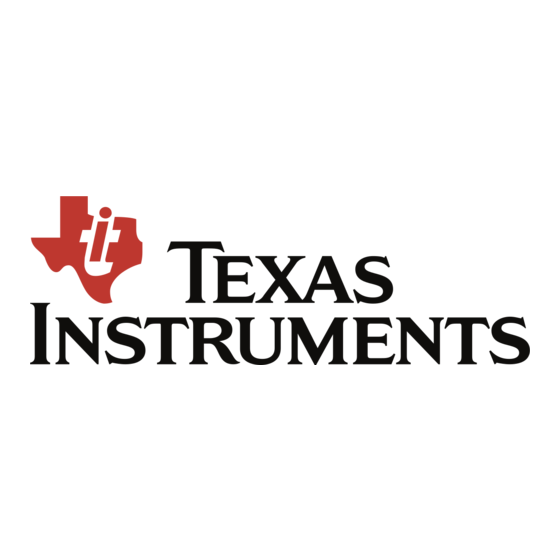Summary of Contents for Texas Instruments eZ430-RF2480
- Page 1 ' s User's Guide eZ430-RF2480 Sensor Monitor SWRU157 2008 Low-Power RF...
-
Page 3: Table Of Contents
Contents EZ430-RF2480 SENSOR MONITOR ... 1 INTRODUCTION ... 2 INSTALLATION... 3 DRIVER INSTALLATION ... 3 3.1. XP... 3 INDOWS 3.2..6 INDOWS ISTA USER INTERFACE ... 8 4.1..10 OOLBAR 4.1.1. Configuration ... 11 4.2..12 ETWORK VIEW 4.2.1. -
Page 4: Introduction
(formerly eZ430-RFZACC06) Sensor Monitor is a PC application that will be used to monitor the sensors in a ZigBee network. The network is formed when setting up the basic out of the box eZ430-RF2480 Demo that includes the ZigBee Accelerator Sample Application (ZASA). -
Page 5: Installation
Driver installation The PC application will communicate with the eZ430-RF2480 dongle over a virtual COM port. The first time the dongle is connected to the PC, the new HW will be detected and the wizard will appear and ask to install the necessary software. The required “inf” file will be installed when installing the PC application. - Page 6 If this warning appears, the option “Continue Anyway” must be selected in order to install the driver. If the IAR kickstart for MSP430 has been installed before this application, it might be that this dialog will pop up and ask the user to select one of the two inf files.
- Page 7 This dialog will be shown when everything been successfully installed. Click Finish to close the wizard.
-
Page 8: Windows Vista
3.2. Windows Vista Select “I don’t have the disc. Show me other options.” The first time the USB dongle (sink) is connected to the PC, the new HW is detected and the system will ask to install driver software. Select “Locate and install driver software”. Select “Browse my computer for driver software.”... - Page 9 The required “inf” file will be installed together with the application. Browse to the directory of the application and select the sub directory “Drivers”. Click Next to continue. At the end the software should be successfully installed. Click Close to end the installation.
-
Page 10: User Interface
In fact, the user does not need to interact with the user interface in order to run the application. When the eZ430-RF2480 dongle is connected to the PC, the application will search for an applicable COM port and start reading if a connection is successfully established. - Page 11 Figure 1: Screenshot of the eZ430-RF2480 Sensor Monitor...
-
Page 12: Toolbar
4.1. Toolbar The list of available COM ports will automatically be updated when the eZ430-RF2480 dongle is connected or disconnected. It is also possible to force refresh of the list by clicking on the green “refresh” button If the applicable COM port can be found when “refresh” has been clicked, the application will automatically try to capture data from the COM port. -
Page 13: Configuration
The “About” button can be clicked to obtain a summary of this application. 4.1.1. Configuration Click on the “Configuration” button and the settings dialog will appear. Temperature unit Celsius or Fahrenheit can be selected. Time interval The timestamp of each node will be checked regularly to see if any message has been received within the given time interval. -
Page 14: The Network View
4.2. The Network view The PC demo will always display one node on the top of the screen, the Sink. Below the Sink the presence of additional network nodes will be displayed as they are detected. The status of the depicted nodes are described below. Sink node not connected to the PC. -
Page 15: Zoom
The meaning of each node is also shown if the mouse is held over the node for more than a second. Note: The Nodes are connected with arrows to show the relationship between parent and child nodes based on the CSKIP addressing scheme. This relationship is with respect to addressing, and does not necessarily reflect the path taken for routing messages between a source and the sink. -
Page 16: Status Bar Troubleshooting
5.5. USB dongle not automatically detected when connected. If the eZ430-RF2480 dongle is not automatically detected, try to remove the dongle and to connect it again. The system could be a bit slow on handling the detection of the dongle being attached or unattached so don’t do this too fast. - Page 17 The serial COM port. The composite device When the eZ430-RF2480 is removed, these device drivers should disappear from the view in the Device Manager. If they don’t disappear, a restart of the PC will be necessary. Check that the “MSP430” device is available in the drop down list of available COM...
-
Page 18: Not Able To Start The Application
5.6. Not able to start the application If an error message about missing the msvcp80.dll is received, or the error message shown below appears when attempting to start the application, you may be required to install an additional package from Microsoft. The package contains some additional runtime components needed by applications developed with Visual C++. -
Page 19: Document History
Document History Revision Date swru157 08/03/2008 Description/Changes Initial release. - Page 20 TI as compliant with ISO/TS 16949 requirements. Buyers acknowledge and agree that, if they use any non-designated products in automotive applications, TI will not be responsible for any failure to meet such requirements. Following are URLs where you can obtain information on other Texas Instruments products and application solutions: Products Amplifiers amplifier.ti.com...









Need help?
Do you have a question about the eZ430-RF2480 and is the answer not in the manual?
Questions and answers